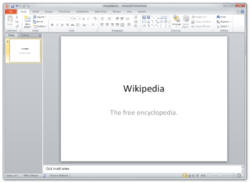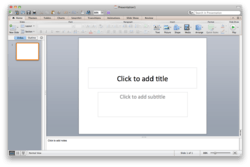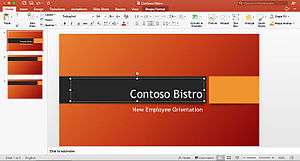Microsoft PowerPoint
 | |
 | |
| Developer(s) | Microsoft |
|---|---|
| Initial release | May 22, 1990 |
| Stable release |
2016 (16.0.4266.1003)
/ 22 September 2015 |
| Written in | C++[1] |
| Operating system | Microsoft Windows |
| Type | Presentation program |
| License | Trialware |
| Website |
office |
|
PowerPoint for Mac 2016 | |
| Developer(s) | Microsoft |
|---|---|
| Stable release | |
| Operating system | Mac OS X |
| Type | Presentation program |
| License | Proprietary commercial software |
| Website |
www |
Microsoft PowerPoint is a slide show presentation program currently developed by Microsoft, for use on both Microsoft and Apple Macintosh operating systems. PowerPoint, initially named "Presenter", was created by Forethought Inc.. Microsoft's version of PowerPoint was officially launched on May 22, 1990, as a part of the Microsoft Office suite. PowerPoint is useful for helping develop the slide-based presentation format and is currently one of the most commonly used slide-based presentation programs available. Microsoft has also released the PowerPoint mobile application for use on Apple and Android mobile operating systems.
History
Originally designed for the Macintosh computer, the initial release was called "Presenter", developed by Thomas Rudkin and Dennis Austin[3] of Forethought, Inc.[4] In 1987, it was renamed to "PowerPoint" due to problems with trademarks, the idea for the name coming from Robert Gaskins.[5]
By then some experts believed that "desktop presentations", using computers to create flip charts and overhead transparencies, could become as large a market as desktop publishing.[6] That year Forethought was bought by Microsoft for $14 million[7][6] ($29.2 million in present-day terms[8]), and became Microsoft's Graphics Business Unit, which continued to develop the software further. Microsoft's version of PowerPoint was officially launched on May 22, 1990, the same day that Microsoft released Windows 3.0.
PowerPoint introduced many new changes with the release of PowerPoint 97. It incorporated the Visual Basic for Applications (VBA) language, underlying all macro generation in Office 97.
PowerPoint 2000 (and the rest of the Office 2000 suite) introduced a clipboard that could hold multiple objects at once, and the Office Assistant was made less intrusive.[9]
PowerPoint 2002 massively overhauled the animation engine, allowing users to create more advanced and custom animations.[10]
PowerPoint 2011 makes it possible to remove image backgrounds, and provides additional special effects for pictures, such as 'Pencil effects'.
As of 2012, various versions of PowerPoint claim ~95% of the presentation software market share, with installations on at least 1 billion computers. Among presenters world-wide, this program is used at an estimated frequency of 350 times per second.[11]
Operation
PowerPoint presentations consist of a number of individual pages or "slides". The "slide" analogy is a reference to the slide projector. Slides may contain text, graphics, sound, movies, and other objects, which may be arranged freely. The presentation can be printed, displayed live on a computer, or navigated through at the command of the presenter. For larger audiences the computer display is often a video projector. Slides can also form the basis of webcasts.
PowerPoint provides three types of movements:
- Entrance, emphasis, and exit of elements on a slide itself are controlled by what PowerPoint calls Custom Animations.
- Transitions, on the other hand, there are movements between slides. These can be animated in a variety of ways.
- Custom animation can be used to create small story boards by animating pictures to enter, exit or move.
PowerPoint provides numerous features that offer flexibility and the ability to create a professional presentation. One of the features provides the ability to create a presentation that includes music which plays throughout the entire presentation or sound effects for particular slides. In addition to the ability to add sound files, the presentation can be designed to run, like a movie, on its own. PowerPoint allows the user to record the slide show with narration and a pointer. The user may customize slide shows to show the slides in a different order than originally designed and to have slides appear multiple times. Microsoft also offers the ability to broadcast the presentation to specific users via a link and Windows Live.
Cultural impact

Supporters say that[12][13][14] the ease of use of presentation software can save a lot of time for people who otherwise would have used other types of visual aid—hand-drawn or mechanically typeset slides, blackboards or whiteboards, or overhead projections. Ease of use also encourages those who otherwise would not have used visual aids, or would not have given a presentation at all, to make presentations. As PowerPoint's style, animation, and multimedia abilities have become more sophisticated, and as the application has generally made it easier to produce presentations (even to the point of having an "AutoContent Wizard" that was discontinued in PowerPoint 2007, suggesting a structure for a presentation), the difference in needs and desires of presenters and audiences has become more noticeable. Experienced PowerPoint designers point out that the "AutoContent Wizard" caused a glitch which contributed greatly to on-screen freezing of slides. Many designers opt to use the "blank slide layout" in lieu of the other layout choices for this reason. Nevertheless, in normal business use, most presentations created using PowerPoint are based on its default layout and font choices.[15]
The benefit of PowerPoint is continually debated, though most people believe that the benefit may be to present structural presentations to business workers, such as Raytheon Elcan does.[16] Its use in classroom lectures has influenced investigations of PowerPoint's effects on student performance in comparison to lectures based on overhead projectors, traditional lectures, and online lectures. There are no compelling results to prove or disprove that PowerPoint is more effective for learner retention than traditional presentation methods.[17] Statistician and designer Edward Tufte suggests that as PowerPoint on its own has limited ability to present complex tables and graphics, a better approach is to provide the audience with printed data and a written report for them to read at the start of the meeting, before leading them through the report with a talk. He noted that after the Columbia disaster, a report on the accident recommended that PowerPoint should never be used as the sole method for presenting scientific material.
Military excess in the US
A "PowerPoint Ranger" is a military member who relies heavily on presentation software to the point of excess. Some junior officers spend the majority of their time preparing PowerPoint slides.[18] Because of its usefulness for presenting mission briefings, it has become part of the culture of the military,[19][20] but is regarded as a poor decision-making tool.[21] As a result, some generals, such as Brigadier-General Herbert McMaster, have banned the use of PowerPoint in their operations.[18] In September 2010, Colonel Lawrence Sellin was fired from his post at the ISAF for publishing a piece critical of the over-dependence of military staffs on the presentation method and bloated bureaucracy.[22]
Artistic medium
Musician David Byrne has been using PowerPoint as a medium for art for years, producing a book and DVD and showing at galleries his PowerPoint-based artwork.[23] The expressions "PowerPoint Art" or "pptArt" are used to define a contemporary Italian artistic movement which believes that the corporate world can be a unique and exceptional source of inspiration for the artist.
PowerPoint Viewer
Microsoft Office PowerPoint Viewer is a program used to run presentations on computers that do not have PowerPoint installed. Office PowerPoint Viewer (or in PowerPoint 2007 and later, a link to a viewer download) is added by default to the same disk or network location that contains one or more presentations packaged by using the Package for CD feature.
PowerPoint Viewer is installed by default with a Microsoft Office 2003 installation for use with the Package for CD feature. The PowerPoint Viewer file is also available for download from the Microsoft Office Online Web site.[24]
Presentations password-protected for opening or modifying can be opened by PowerPoint Viewer. The Package for CD feature allows packaging any password-protected file or setting a new password for all packaged presentations. PowerPoint Viewer prompts for a password if the file is open password-protected.
PowerPoint Viewer supports opening presentations created using PowerPoint 97 and later. In addition, it supports all file content except OLE objects and scripting. PowerPoint Viewer is currently only available for computers running on Microsoft Windows.
Versions

| Year | Name | Version | Comments |
|---|---|---|---|
| 1990 | PowerPoint 2.0 for Windows 3.0 | 2.0 | Renumbered to match contemporary Macintosh version |
| 1992 | PowerPoint 3.0 for Windows 3.1 | 3.0 | |
| 1993 | PowerPoint 4 | 4.0 | |
| 1995 | PowerPoint for Windows 95 | 7.0 | Renumbered to match contemporary version of Word |
| 1997 | PowerPoint 97 | 8.0 | |
| 1999 | PowerPoint 2000 | 9.0 | |
| 2001 | PowerPoint 2002 | 10.0 | |
| 2003 | Office PowerPoint 2003 | 11.0 | |
| 2007 | Office PowerPoint 2007 | 12.0 | |
| 2010 | PowerPoint 2010 | 14.0 | Due to superstitions surrounding the number 13, PowerPoint 13 was skipped in version counting. |
| 2013 | PowerPoint 2013 | 15.0 | |
| 2015 | PowerPoint 2016 | 16.0 |

| Year | Name | Version | Comments |
|---|---|---|---|
| 1987 | PowerPoint 1 | 1.0 | Initial version of PowerPoint |
| 1988 | PowerPoint 2 | 2.0 | |
| 1992 | PowerPoint 3 | 3.0 | |
| 1994 | PowerPoint 4 | 4.0 | |
| 1998 | PowerPoint 98 | 8.0 | Renumbered to match contemporary version of Word, and contemporary Windows version |
| 2000 | PowerPoint 2001 | 9.0 | |
| 2001 | PowerPoint X | 10.0 | |
| 2004 | PowerPoint 2004 | 11.0 | |
| 2008 | PowerPoint 2008 | 12.0 | |
| 2010 | PowerPoint 2011 | 14.0 | As with the Windows version, version 13 was skipped for superstitious reasons. |
| 2015 | PowerPoint 2016 | 15.0 |
File formats
| Filename extension |
.ppt, .pptx, .pps, or .ppsx |
|---|---|
| Internet media type |
application/vnd.ms-powerpoint |
| Type code | uniforcom.microsoft.powerpoint.ppt[25] |
| Developed by | Microsoft |
| Type of format | Presentation |
The binary format specification has been available from Microsoft on request, but since February 2008 the .ppt format specification can be freely downloaded.[26]
In Microsoft Office 2007 the binary file formats were replaced as the default format by the new XML-based Office Open XML formats, which are published as an open standard. Nevertheless, they are not complete as there are binary blobs inside of the XML files, and several pieces of behaviour are not specified but refer to the observed behaviour of specific versions of Microsoft product.
See also
- Google Slides
- Keynote (presentation software), the iWork presentation software used for Macintosh
- LibreOffice Impress
- OpenOffice Impress
- Calligra Stage
- Microsoft Office password protection
- PowerPoint animation
- Powerpoint-Karaoke
- Prezi
- AppleWorks, a discontinued office suite that included a presentation program meant to compete with PowerPoint
References
- ↑ Lextrait, Vincent (January 2010). "The Programming Languages Beacon, v10.0". Retrieved 5 January 2010.
- ↑ "Description of the security update for Office 2016 for Mac: July 12, 2016".
- ↑ Austin, Dennis. "Beginning of PowerPoint: A Personal Technical Story". Retrieved 23 August 2014.
- ↑ Gaskins, Robert (14 August 1984). "Sample Product Proposal: presentation graphics for overhead projection" (PDF). Retrieved 19 August 2009.
- ↑ Atkinson, Max (19 August 2009). "The problem with PowerPoint". BBC News.
- 1 2 "Microsoft Buys Software Unit". The New York Times. 1987-07-31. Retrieved 26 October 2016.
- ↑ Zonona, Victor F. (1987-07-31). "$14-Million Deal : Microsoft Buys Software Competitor". Los Angeles Times. Retrieved 26 October 2016.
- ↑ Federal Reserve Bank of Minneapolis Community Development Project. "Consumer Price Index (estimate) 1800–". Federal Reserve Bank of Minneapolis. Retrieved October 21, 2016.
- ↑ Swartz, Luke (12 June 2003). "Why People Hate the Paperclip".
- ↑ "Timeline – The animation engine in PowerPoint".
- ↑ Parks, Bob (2012-08-30), "Death to PowerPoint!", Bloomberg Businessweek, businessweek.com, retrieved 6 September 2012
- ↑ "PowerPoint Presentations: The Good, The Bad and The Ugly". Shkaminski.
- ↑ Allan, Jones (18 August 2003). "The use and abuse of PowerPoint in Teaching and Learning in the Life Sciences: A Personal Overview". Bioscience Education. Retrieved 10 February 2009.
- ↑ "The Use of PowerPoint in Teaching Comparative Politics". Technology Source.
- ↑ Themann, Tim. "Visual Logorrhea – On the Prevalence of Slideuments". Retrieved 23 August 2014.
- ↑ Tufte, Edward (September 2003). "PowerPoint Is Evil – Power Corrupts. PowerPoint Corrupts Absolutely.". Wired. Condé Nast Digital. Archived from the original on April 15, 2014. Retrieved April 15, 2014.
- ↑ Savoy, April (30 January 2009). "Information retention from PowerPoint; and traditional lectures". Computers & Education. Retrieved 5 March 2009.
- 1 2 Evans, MIchael (April 28, 2010), Afghanistan: the battle for hearts and bullet points, The Times
- ↑ Bumiller, Elisabeth (April 26, 2010). "We Have Met the Enemy and He Is PowerPoint". The New York Times. Retrieved 27 April 2010.
- ↑ Starbuck (July 2009). "The TX Hammes PowerPoint Challenge (Essay Contest)". Small Wars Journal. Retrieved 27 April 2010.
- ↑ Hammes, T.X. (July 2009). "Essay: Dumb-dumb bullets". Armed Forces Journal. Retrieved 27 April 2010.
- ↑ Sellin, Lawrence (September 5, 2010). "The PowerPoint rant that got a colonel fired". United Press International. Army Times. Retrieved 8 September 2010.
- ↑ http://www.davidbyrne.com/art/eeei/index.php
- ↑ "PowerPoint Viewer". Download Center. Microsoft. 25 November 2011. Retrieved 6 July 2014.
- ↑ System-Declared Uniform Type Identifiers Archived July 24, 2008, at the Wayback Machine.
- ↑ "Microsoft Office Powerpoint 97 - 2007 Binary File Format Specification (*.ppt)". Microsoft Corporation. 2007.
Further reading
- Reuss, E.I. & Signer, B. & Norrie, M.C. (2008) "PowerPoint Multimedia Presentations in Computer Science Education: What do Users Need?" In Proceedings of the 4th Symposium on Usability & HCI for Education and Work (USAB 2008). Graz, Austria.
- Lowenthal, P. R. (2009). Improving the Design of PowerPoint Presentations . In P. R. Lowenthal, D. Thomas, A. Thai, & B. Yuhnke, B. (Eds.), The CU Online handbook. Teach differently: Create and collaborate (pp. 61–66). Raleigh, NC: Lulu Enterprises.
- Kalyuga, Slava; Chandler, Paul; Sweller, John (2004). "When Redundant On-Screen Text in Multimedia Technical Instruction Can Interfere With Learning". Human Factors: The Journal of the Human Factors and Ergonomics Society. 46 (3): 567–581. doi:10.1518/hfes.46.3.567.50405. PMID 15573552. Retrieved 11 February 2015., also at (Feb 2015).
External links
| Wikibooks has a book on the topic of: Microsoft Office/Creating and Editing a Presentation |
| Wikimedia Commons has media related to Microsoft PowerPoint. |
- Official website
- PowerPoint team blog at MSDN Blogs
- PowerPoint Viewer
- Microsoft PowerPoint at DMOZ
- Robert Gaskins's website, one of the PowerPoint developers

